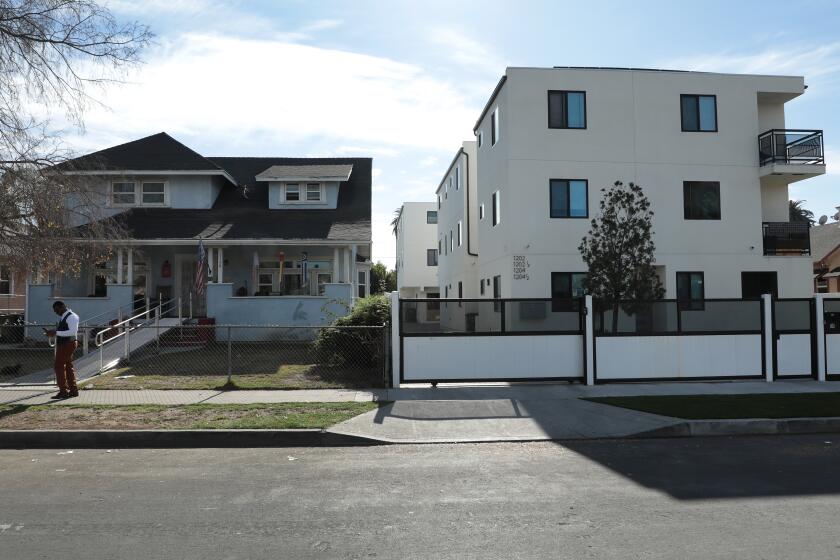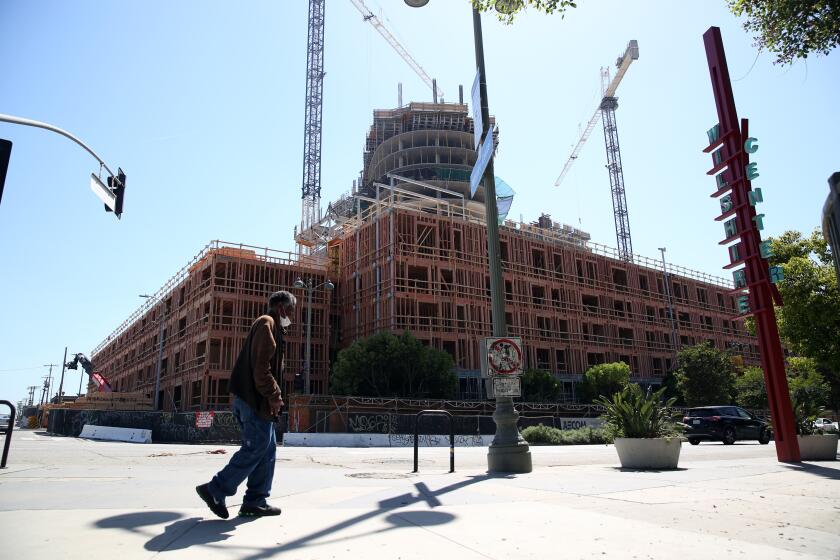Opinion: Why is California behind Texas and other states in curbing homelessness?

- Share via
Rent is surging nationwide. Homelessness rates rose an astonishing 15% on average in major cities last year. It seems like the rest of the United States is waking up to what California has been living for decades.
But underneath these headlines emerges a more hopeful story as some metropolitan areas make significant progress to render homelessness rare and brief. Raleigh, N.C., led major U.S. cities in reducing homelessness by 40% between 2022 and 2023. Texas cities also stand out: Last year, the Houston metropolitan area achieved the lowest rate of homelessness of any major U.S. city, with just 52 people per 100,000 residents experiencing homelessness (compared to 734 people per 100,000 in Los Angeles). Even Austin, which has a higher homelessness rate than other cities in the state, reduced homelessness by 25% in one year.
The city put forth ambitious programs to meet California mandates for affordable housing — and then weakened them by exempting single-family neighborhoods.
Meanwhile, five of the top 10 major cities with the highest rates of homelessness nationally are in California: San Francisco, Long Beach, Los Angeles, Oakland and Sacramento, in that order. In 2022, the homelessness rate in San Francisco was nearly 20 times higher than in Houston, and Los Angeles’ was almost 14 times higher. Over the longer term, homelessness in Los Angeles rose 56% between 2015 and 2022, while it declined in Houston by 32%.
So what is making the difference in Texas and elsewhere? Can progress reach big cities in California, the state that is home to 28% of the entire country’s homeless population ?
First and foremost, other places are building more housing of all types. The Houston, Dallas-Fort Worth and Austin metro areas are all in the top 10 for housing production, while San Francisco, Los Angeles and San Jose are all in the back half of the pack. These metro areas are also working together on a regional approach to homelessness that differs from California’s largely fragmented response. For example, in Houston, one planning body — called a continuum of care — coordinates federal dollars and homelessness response across the metropolitan area. In California, every county and also some municipalities have separate continua of care.
Developers built fewer homes in California in 2023, potentially leading to higher prices and rents as a supply shortage worsens.
The Golden State has treated the housing shortage with urgency and adopted reforms to the Regional Housing Needs Allocation planning process to increase housing supply, including affordable housing for qualifying households, dramatically by 2030. Such a plan is necessary. But it will of course take years to complete.
In the meantime, our leaders have a moral, political and economic mandate to reduce the harm that homelessness inflicts on individuals, families and communities. And there are more solutions California cities can adopt today to address homelessness. While some may dismiss temporary interventions such as safe camping, parking and shelter as mere window dressing compared to long-term solutions, the reality is that people experiencing homelessness struggle every day to find somewhere to rest.
First, localities should recognize that an ounce of prevention is worth a pound of cure. Just 3.6% of Los Angeles County’s 2022-2023 homelessness spending was devoted to prevention such as emergency rental assistance, eviction defense and direct payments. But the recent availability of once-in-a-generation federal aid during the pandemic created a natural experiment that showed the potential of spending more on preventing people from becoming homeless in the first place.
Rental subsidies, eviction defense and help finding new housing are prevention efforts that could help vulnerable people from falling into homelessness.
Just to the north in Santa Clara County, for instance, homelessness grew by 31% between 2017 and 2019. Then, during the pandemic, the county reached an estimated 16,000 vulnerable households with prevention assistance, and homelessness grew by only 3% between 2019 and 2022.
California’s biggest metro areas can also improve their approach to the overlap between mental health and homelessness. Texas cities including Houston and Dallas have had success with the Housing First model that focuses on getting people into housing before tackling other issues they face, such as addiction. Bad-faith attacks against this strategy, in California and elsewhere, aren’t backed by real evidence.
We also need better ways to respond to people with behavioral health and substance abuse emergencies that do not automatically expose them to police while also respecting everyone’s right to be safe. Models from Denver and other cities provide a roadmap to do so. One study found that Denver’s use of emergency mental health professionals reduced crime and cost less than a traditional police response.
Los Angeles has already begun implementing an alternative crisis response model, but staffing challenges have hampered its effectiveness, indicating a need for workforce development. Those efforts can complement the county’s Office of Diversion and Reentry Housing program, which has had success disrupting the cycle of incarceration and homelessness (about a quarter of the county jail population is homeless).
In addition, although business improvement districts are sometimes seen as inherently antagonistic toward homeless people, they can be innovative and effective partners. In Philadelphia, D.C., New York and elsewhere, such groups have implemented practices such as community ambassadors who help people experiencing homelessness connect with housing, services and treatment; free access to drinking water and bathrooms; and placemaking activities such as games that promote safety and belonging in public space.
The homelessness numbers may paint a bleak picture. But the availability of these strategies makes clear that California is much closer to hope than it seems.
Tracy Hadden Loh and Hanna Love are fellows at the Brookings Institution.
More to Read
A cure for the common opinion
Get thought-provoking perspectives with our weekly newsletter.
You may occasionally receive promotional content from the Los Angeles Times.













